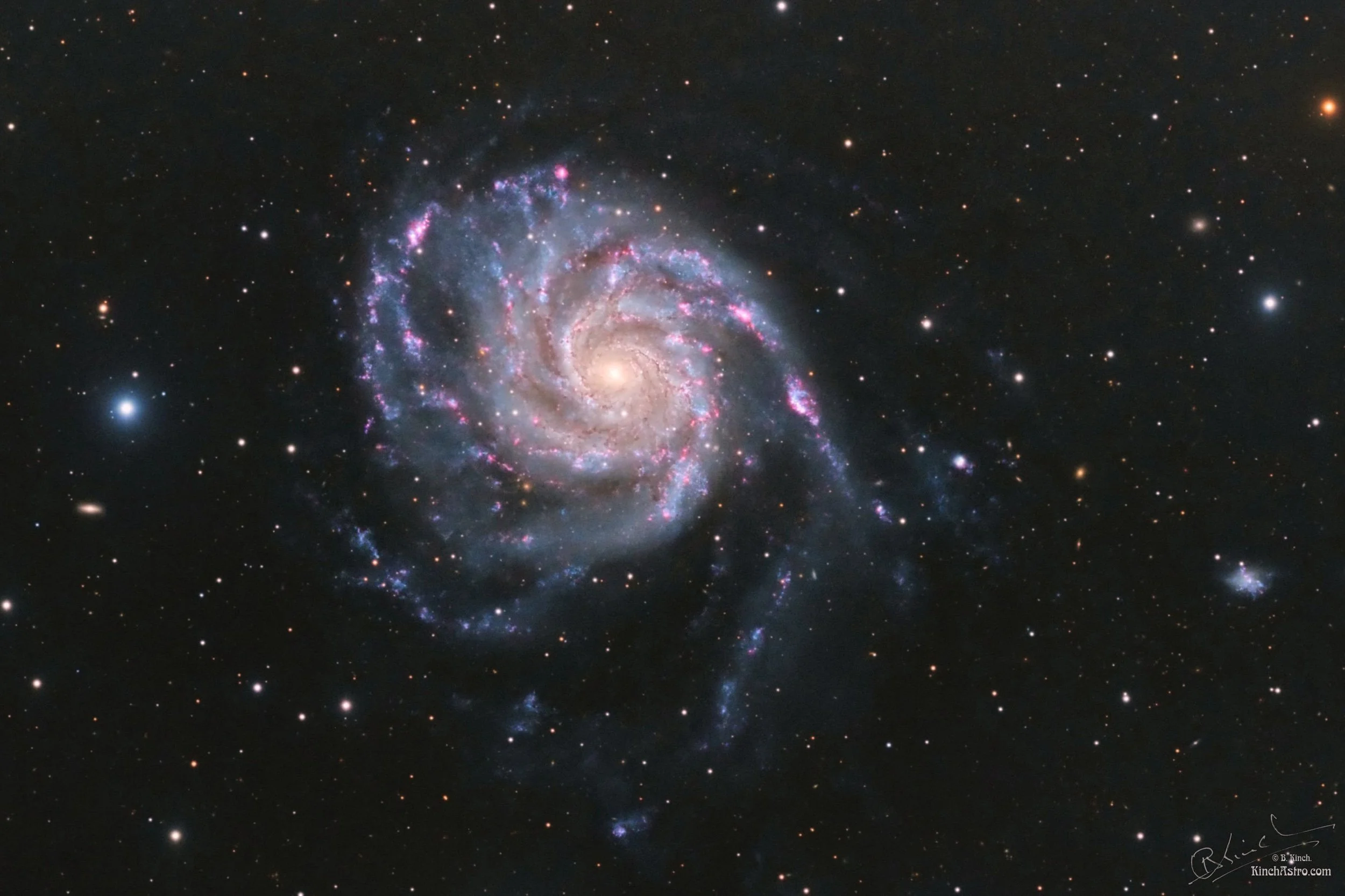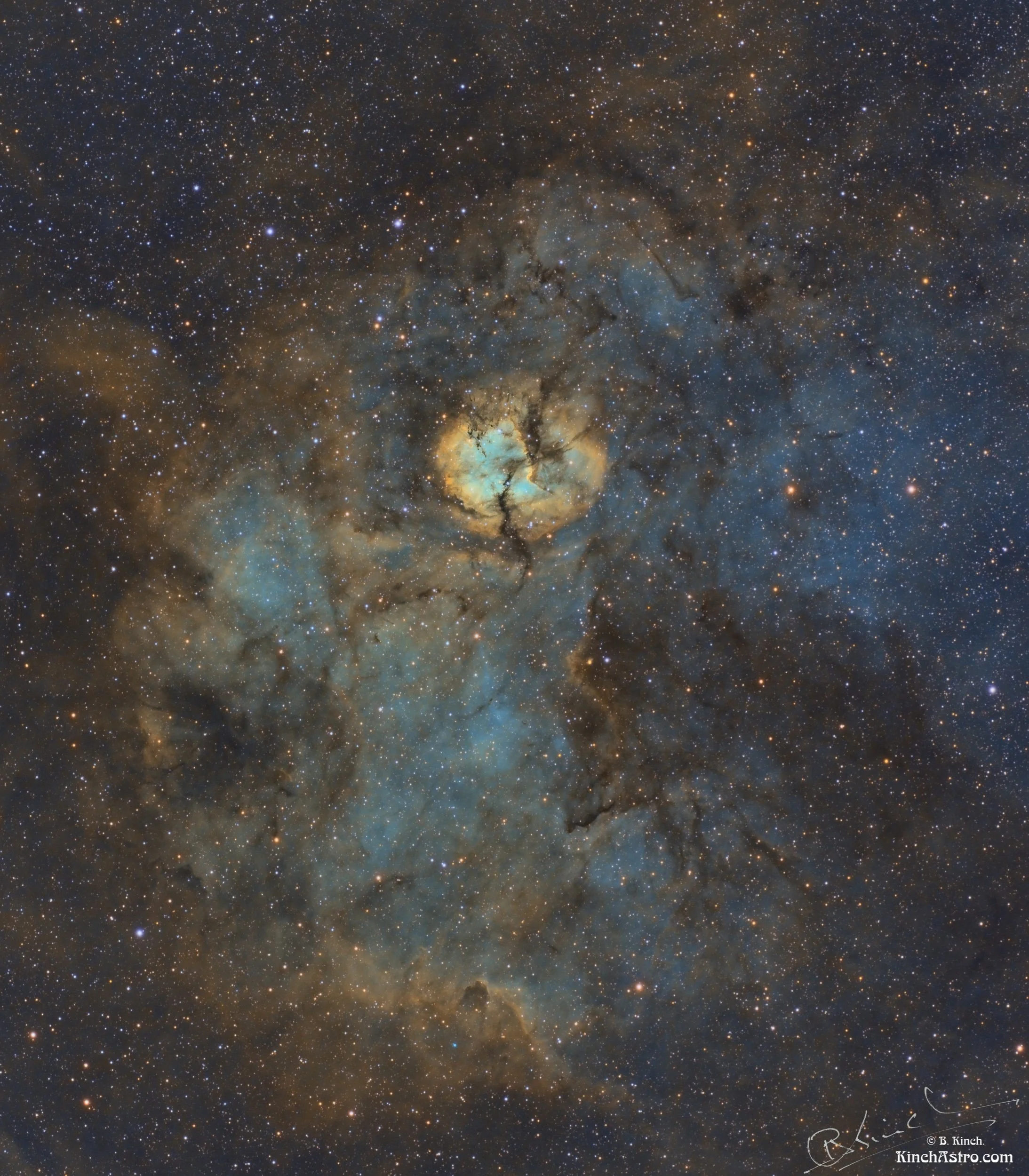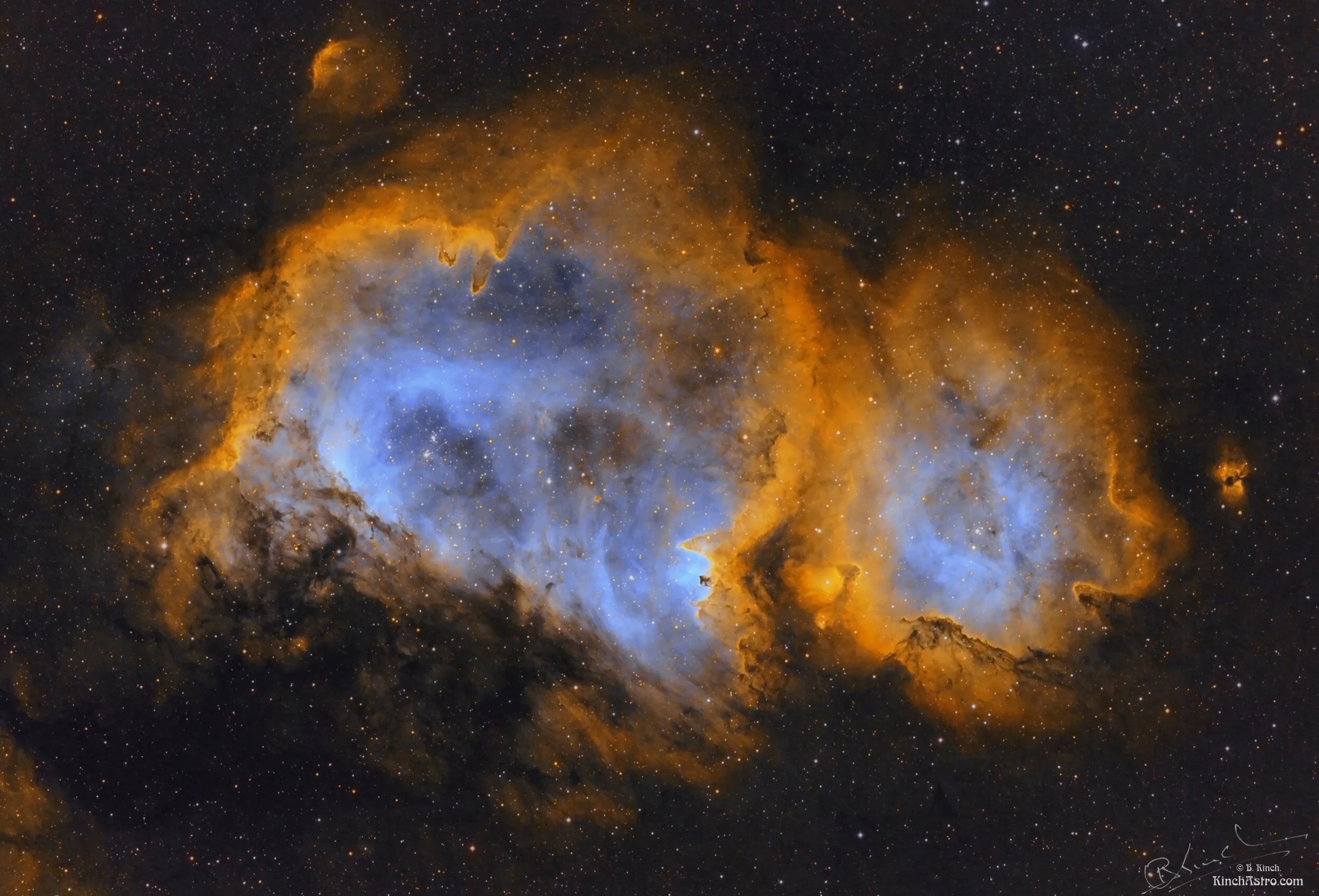
AAPOD2 Image Archives
Alves 2: A Dark Nebula in Taurus
Alves 2 is a subtle and enigmatic dark nebula nestled in the constellation Taurus. Part of a larger complex of interstellar dust, it obscures the light from background stars, appearing as an inky void against the dense star fields of the Milky Way. Its faint structure requires long exposures and precise imaging to reveal the intricate shapes and textures of the dust clouds.
Captured from a backyard in Cartagena, Spain, on January 2, 2025, Brendan Kinch’s image showcases the delicate beauty of Alves 2 using a personal telescope setup. This challenging target emphasizes the quiet mystery of dark nebulae, where dense molecular clouds serve as potential cradles for star formation. Hidden within its shadows may lie the seeds of future stars, illustrating the silent yet essential role of dark nebulae in the cycle of cosmic evolution.
CTA 1
This fascinating image captures CTA 1, a vast and faint supernova remnant in the constellation Cepheus. Thought to have been formed by a supernova explosion around 10,000 years ago, CTA 1 spans a wide region approximately 4,600 light-years from Earth. This supernova remnant is an elusive target for astrophotographers due to its dim luminosity and diffuse structure, making it a remarkable sight when imaged in such detail.
The designation "CTA 1" comes from the California Institute of Technology's (Caltech) first radio source catalog, published in 1960. While often collectively referred to as G119.5+10.2, this expansive remnant also includes substructures cataloged as G119.5+9.8 and G119.5+10.0, highlighting its complex morphology.
Adding a striking contrast to the ethereal backdrop of CTA 1 is the planetary nebula NGC 40, prominently visible near the center-right of the image. Often nicknamed the Bowtie Nebula, this bipolar planetary nebula glows brightly as the central dying star sheds its outer layers, creating a stunning interplay of structure and color.
This image showcases the celestial interplay of endings and beginnings: the diffuse remains of a supernova explosion, which seeded the cosmos with elements for future star formation, juxtaposed with the beautiful remnants of a star nearing the end of its life. It’s a rare and mesmerizing look at Cepheus' hidden treasures.
Pelican & Wall
The captivating Pelican Nebula, an intricate star-forming region within the Cygnus constellation. Spanning across vast expanses of space, the Pelican Nebula showcases a tapestry of interstellar gas and dust, intricately shaped by the forces of gravity and stellar activity. Deep within its ethereal embrace, young, hot stars illuminate the nebula, their intense radiation causing the surrounding hydrogen gas to glow in shades of crimson and pink.
In the large FOV of this image, the Cygnus Wall emerges as a striking feature—a dense ridge of gas and dust that serves as a stellar nursery, nurturing the birth of new stars. This dynamic interplay of stellar processes and cosmic forces within the Pelican Nebula and the Cygnus Wall offers use a glimpse into the fascinating mechanisms driving the formation and evolution of stars in our universe.
M 101 - Pinwheel Galaxy
Image Description and Details : The Pinwheel Galaxy (also known as Messier 101, M101 or NGC 5457) is a face-on spiral galaxy distanced 21 million light-years (six megaparsecs) away from Earth in the constellation Ursa Major. Discovered by Pierre Méchain on March 27, 1781, it was communicated to Charles Messier who verified its position for inclusion in the Messier Catalogue as one of its final entries.
M101 is a large galaxy, with a diameter of 170,000 light-years. By comparison, the Milky Way has a diameter of 100,000 light years. It has around a trillion stars, a little more than twice the number in the Milky Way. It has a disk mass on the order of 100 billion solar masses, along with a small central bulge of about 3 billion solar masses.
M101 has a high population of H II regions, many of which are very large and bright. H II regions usually accompany the enormous clouds of high density molecular hydrogen gas contracting under their own gravitational force where stars form. H II regions are ionized by large numbers of extremely bright and hot young stars; those in M101 are capable of creating hot super-bubbles.
M101 is asymmetrical due to the tidal forces from interactions with its companion galaxies. These gravitational interactions compress interstellar hydrogen gas, which then triggers strong star formation activity in M101's spiral arms that can be detected in ultraviolet images.
Imaging telescopes or lenses: Takahashi FSQ130ED
Imaging cameras: QSI 6120i
Mounts: Takahashi EM 400 Temma 2M
Guiding telescopes or lenses: Takahashi FS60CB
Guiding cameras: QHY CCD QHY 5 II
Focal Extender / Reducer: None
Software: Sequence Generator Pro SGP (for capture) PHD 2 (guiding), Astro Pixel Processor & PixInsight,
Filters: Astrodon LRGB Astrodon Ha (3nm)
Dates: 3rd Mar 2019 - 8th Mar 2019 AND 22nd March 2023
Copyright: Brendan Kinch
Sh2-124
Image Description and Details : I am just going to say what everybody else seems to say: “SH2-124 is an emission nebula in northern Cygnus at about 8.500 light years away. It doesn’t seem to be imaged very often, and I was not able to find much additional information about it.”
Not imaged very often but I think with sufficient exposure – this area makes a lovely target for an image.
Imaging telescope: Takahashi FSQ106ED
Imaging camera: ASI 2600MM
Mount: Takahashi EM 400 Temma 2M
Guiding telescope: Takahashi FS60CB
Guiding camera: QHY CCD QHY 5 II
Focal Extender / Reducer: None
Capture Software: Sequence Generator Pro, PHD 2
Processing Software: Astro Pixel Processor, PixInsight, Topaz DeNoise, Photoshop
Filters (50mm): Astrodon Ha (3nm), Astrodon SII (3nm) & Astrodon OIII (3nm)
Accessories: ATIK EFW3, SeleTEK2 controlling Robofocus Focuser.
Dates: 15th - 19th Aug 2022
Frames:
Astrodon Ha 42 x 10'
Astrodon SII 42 x 10'
Astrodon OIII 42 x 10'
Total integration = 21 Hours
Copyright: Brendan Kinch
Sh2-224
Image Description and Details :
Sh2-224 is a supernova remnant visible in the constellation of Auriga. It is situated 3.5 ° to SSE of the bright star Capella, the dominant star of the constellation. It is formed by two soft nebulous filaments, the most conspicuous of which is that of the northwest and extends for 20 'x 30' towards the center of the source of radio waves, which has dimensions of 70 'x 75'. The object has an unusual shape, with a shell structure with a radius of about 25 parsec, and is in interaction with a cavity of the interstellar medium at a higher temperature than the surrounding environment, located in the south-western part and of the arch. This conformation suggests that the rest of the supernova in the southwest direction has come into contact with the cavity, first deforming and entering into interaction with this structure, then expanding inside it and creating a wider propagation wave that has emerged from the opposite part, thus creating the arch structure visible in the westernmost part, ie beyond the cavity. The distance of the structure is estimated at about 14,700 light years from the solar system, in a peripheral region of the Arm of Perseus. The X-ray study determined an age of the structure between 13,000 and 24,000 years.Imaging telescopes or lenses: Takahashi FSQ130EDImaging cameras: ASI 2600MM-PMounts: Takahashi EM 400 Temma 2MGuiding telescopes or lenses: Takahashi FS60CBGuiding cameras: QHY CCD QHY 5 IIFocal Extender / Reducer: NoneSoftware: PHD 2, Pleiades Astrophoto PixInsight , Astro Pixel Processor (for stacking), Sequence Generator Pro SGP (for capture)Filters: Astrodon Ha, OIII & RGBAccessories: SeleTEK2/Robofocus Focuser, ATIK EFW3Original Image: 6237 x 4167 Dates: 2nd Dec - 14th Dec '21 Frames: Astrodon Ha 60 x 10' Astrodon OIII 48 x 10' RGB 3 x 15 x 2'Total Time: 19 Hours 30 Mins.Center (RA, Dec): (81.717, 42.933)Center (RA, hms): 05h 26m 51.963sCenter (Dec, dms): +42° 55' 58.987"Size: 85.9 x 57.4 arcminRadius: 0.861 degPixel scale: 1.2 arcsec/pixelOrientation: Up is 270 degrees E of N
Copyright: Brendan Kinch
Soul Nebula
This complex is the eastern neighbor of IC1805 (Heart Nebula) and the two are often mentioned together as the "Heart and Soul". Located about 6,000 light-years from Earth, the Heart and Soul nebulae form a vast star-forming complex that makes up part of the Perseus spiral arm of our Milky Way galaxy. The Soul nebula is also known as the Embryo nebula, IC 1848 or W5.The Perseus arm lies further from the centre of the Milky Way than the arm that contains our sun. The Heart and Soul nebulae stretch out nearly 580 light-years across; the diameter of the Milky Way, is roughly 100,000 light-years across.Imaging telescope: Takahashi FSQ130EDImaging cameras: FLI ML16200Mounts: Takahashi EM 400 Temma 2MGuiding cameras: QHY CCD QHY 5 IIFocal Extender / Reducer: Tak QE 0.73x Software: PHD 2, Astro Pixel Processer, PixInsight , Sequence Generator Pro SGPFilters: Astrodon Ha + Astrodon OIII + Astrodon SIIAccessories: ATIK EFW3Original Resolution: 3500 x 2500 Dates: Sep 15 - Oct 5, 2021Frames:Astrodon Ha: 42 x 600"Astrodon OIII: 42 x 600"Astrodon SII: 42 x 600"Integration: 21 Hours.Center (RA, Dec): (43.568, 60.344)Center (RA, hms): 02h 54m 16.291sCenter (Dec, dms): +60° 20' 38.560"Size: 2.52 x 1.8 degRadius: 1.551 degPixel scale: 2.6 arcsec/pixelOrientation: Up is 180 degrees E of N
Copyright: Brendan Kinch
NGC 6914 & Propeller Nebula
Image Description and Details :
A cropped & rotated rendition of my 1st attempt of this area. I made more effort to control the stars to better show the nebulosity. NGC 6914 & Propeller Nebula are perhaps the better known targets within the image.The Sadr Region (also known as IC 1318 or the Gamma Cygni Nebula) is the diffuse emission nebula surrounding Sadr (γ Cygni) at the centre of Cygnus's cross. The Sadr Region is one of the surrounding nebulous regions; others include the Butterfly Nebula and the Crescent Nebula (not shown in this image). It contains many dark nebulae in addition to emission diffuse nebulae.Imaging telescope: Takahashi FSQ130EDImaging cameras: FLI ML16200Mounts: Takahashi EM 400 Temma 2Guiding cameras: QHY CCD QHY 5 IIFocal Extender / Reducer: Tak QE 0.73x Software: PHD 2, Astro Pixel Processer, PixInsight , Sequence Generator Pro SGPFilters: Astrodon SII, Ha & OIIIAccessories: ATIK EFW3Original Resolution: 4473 x 3578Dates: Jun 10 - Jun 21, 2021Frames:Astrodon Ha: 36 x 600"Astrodon SII: 30 x 600"Astrodon OIII: 30 x 600"Integration: 16 Hours.
Copyright: Brendan Kinch
SH2-200
Image Description and Details :
This nebula was first discovered by the astronomer Stewart Sharpless in 1959 who included it in his catalogue of HII regions under the name of Sh2-200. In 1983, Sh2-200 was included in the HDW catalogue of possible planetary nebulae by the astronomers Herbert Hartl, Johann Dengel and Ronald Weinberger. However it wasn't confirmed to be a true genuine planetary nebula until 2017 when spectra was taken as part of professional observations. In 1987, further narrowband observations by Herbert Hartl and Ronald Weinberger detected a large faint outer halo extending further than the central shell.Imaging telescopes or lenses: Takahashi FSQ130EDImaging cameras: QSI 6120iMounts: Takahashi EM 400 Temma 2Guiding cameras: QHY CCD QHY 5 IIDates: Nov. 22 - Dec. 12, 2020Frames:Astrodon Ha 5nm: 45x1200" Astrodon OIII 5nm: 45x1200"Astrodon RGB: 3x30x120" Integration: 33 Hours
Copyright: Brendan Kinch
Soul Nebula [IC 1848]
Located about 6,000 light-years from Earth, the Heart and Soul nebulae form a vast star-forming complex that makes up part of the Perseus spiral arm of our Milky Way galaxy. The Soul nebula is also known as the Embryo nebula, IC 1848 or W5.
Rosette Nebula
Imaging telescopes or lenses: Takahashi FSQ130ED
Imaging cameras: FLI ML16200 ADT
Mounts: Takahashi EM 400 Temma 2M
Guiding telescopes or lenses: Takahashi FS60CB
Guiding cameras: QHY CCD QHY 5 II
Focal Extender / Reducer: None
Software: Sequence Generator Pro SGP (for capture) PHD 2 (guiding), Astro Pixel Processor & PixInsight,
Filters: Astrodon Ha, OIII, SII.
Accessories: Robofocus Focuser, ATIK EFW3
Original Resolution: 3570 x 4225
Dates: 1st Jan to 4th Jan 2020
Frames:
Astrodon Ha 30 x 10'
Astrodon OIII 30 x 10'
Astrodon SII 36 x 10'
Total integration = 16 hours.
Copyright: Brendan Kinch













![Soul Nebula [IC 1848]](https://images.squarespace-cdn.com/content/v1/5debd4b16fcd7b02905712ff/1587991968158-T7Y4QUMS2B7GROINBWA4/this_is_final_soul_nebula.jpg)
